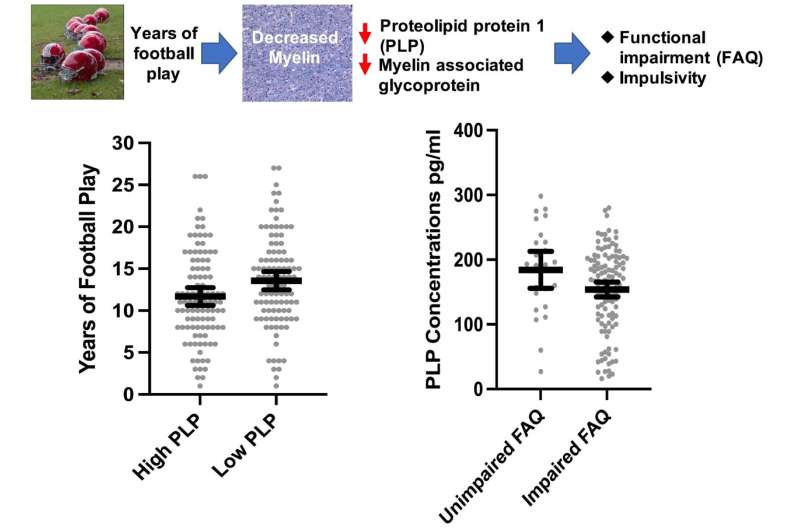Graphical abstract. Credit: (2023). DOI: 10.1093/braincomms/fcad019
Chronic traumatic encephalopathy (CTE) is not the only problem football players should be aware of. Long careers in American football are linked to less white matter in the brain and associated with problems with impulsive behavior and thinking according to a new study from the Boston University CTE Center. This finding is independent of whether football players had chronic traumatic encephalopathy (CTE).
CTE is a progressive neurodegenerative disease frequently found in contact sports athletes. However, many former contact sports athletes suffer from thinking problems and impulsive behavior in the absence of CTE, or with very mild CTE. This new study suggests that a separate type of brain damage, which can appear earlier than CTE, may underlie some of these symptoms.
"Damage to the white matter may help explain why football players appear more likely to develop cognitive and behavioral problems later in life, even in the absence of CTE," said corresponding author Thor Stein, MD, Ph.D., a neuropathologist at VA Boston Healthcare System and assistant professor of pathology and laboratory medicine at Boston University Chobanian & Avedisian School of Medicine.
The researchers studied the brains of 205 deceased American football players donated to the Veterans Affairs-Boston University-Concussion Legacy Foundation (VA-BU-CLF) Brain Bank and measured levels of myelin, a component of white matter that covers, protects and speeds up the connections in the brain.
They then interviewed family members on measures of cognition and impulsivity and then compared how career length and age of beginning tackle football related to levels of myelin, and how myelin levels related to cognition and impulsivity. In addition to more years of football played, the researchers found that starting tackle football at a younger age was also related to more white matter loss, independent of career length.
"These results suggest that existing tests that measure white matter injury during life, including imaging and blood tests, may help to clarify potential causes of changes in behavior and cognition in former contact sport athletes. We can also use these tests to better understand how repeated hits to the head from football and other sports lead to long term injury to the white matter," said co-author Michael L. Alosco, Ph.D., associate professor of neurology.
The researchers hope these findings help reinforce the idea that more needs to be done to protect the brains of athletes, especially children, from repeated hits to the head.
These findings are forthcoming in the journal Brain Communications.
More information: Michael Alosco et al, Decreased myelin proteins in brain donors exposed to football-related repetitive head impacts, Brain Communications (2023). DOI: 10.1093/braincomms/fcad019
Journal information: Brain Communications
Provided by Boston University School of Medicine























